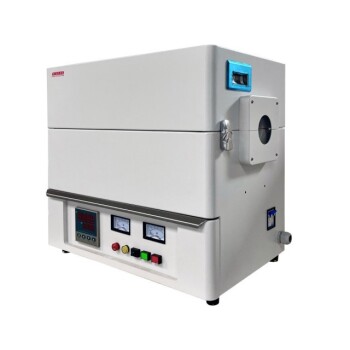Vertical and horizontal tube furnaces differ significantly in temperature control and uniformity due to their structural and operational differences. Vertical furnaces excel in uniform heating along the sample length, leveraging gravity and convection for consistent results, while horizontal furnaces may require more optimization to counteract potential temperature gradients. Both are widely used in materials science and industrial processes, with vertical furnaces often preferred for precise applications like CVD, and horizontal furnaces favored for batch processing and larger samples.
Key Points Explained:
-
Temperature Uniformity Mechanisms
- Vertical Tube Furnaces:
- Heating elements surround the tube, enabling efficient heat transfer via radiation and convection.
- Gravity aids in uniform heat distribution, minimizing temperature gradients along the sample length.
- Ideal for processes like chemical vapor deposition (CVD) and pyrolysis, where precision is critical.
- Horizontal Tube Furnaces:
- Heat transfer relies more on radiation, which can lead to slight variations along the tube length.
- Requires careful optimization of temperature profiles (e.g., multi-zone heating) to ensure uniformity.
- Vertical Tube Furnaces:
-
Sample Handling and Orientation
- Vertical Furnaces:
- Easier loading/unloading for long or vertically aligned samples (e.g., nanowires).
- Minimizes sample displacement during heating.
- Horizontal Furnaces:
- More complex handling for larger/multiple samples, often needing trays or supports.
- Better suited for batch processing in industries like metallurgy.
- Vertical Furnaces:
-
Industrial Applications
- Vertical: Preferred in nanotechnology and chemistry for high-precision thermal processes.
- Horizontal: Common in sintering, annealing, and heat treatment of bulk materials.
-
Design Features Impacting Performance
- Single-zone vs. multi-zone heating: Multi-zone horizontal furnaces mitigate uniformity issues.
- Cooling mechanisms (e.g., water-cooled end caps) enhance control in both types.
-
Practical Considerations for Buyers
- Vertical furnaces offer "set-and-forget" simplicity for uniform heating.
- Horizontal furnaces provide flexibility for larger samples but may need additional calibration.
Did you know? The choice between these furnaces often hinges on whether your process prioritizes precision (vertical) or throughput (horizontal).
Summary Table:
| Feature | Vertical Tube Furnace | Horizontal Tube Furnace |
|---|---|---|
| Temperature Uniformity | High, due to gravity and convection | Requires multi-zone optimization |
| Sample Handling | Easier for vertical samples | Better for batch processing |
| Best For | Precision processes like CVD | Bulk material processing |
| Design Flexibility | Limited by vertical orientation | More adaptable for larger samples |
Upgrade your lab with the right furnace for your needs! At KINTEK, we specialize in high-temperature furnace solutions tailored to your unique requirements. Whether you need the precision of a vertical tube furnace for CVD or the versatility of a horizontal furnace for batch processing, our advanced R&D and in-house manufacturing ensure top-tier performance. Contact us today to discuss how we can enhance your thermal processing capabilities!
Products You Might Be Looking For:
View high-precision vacuum observation windows
Explore vacuum electrode feedthroughs for precision applications



















